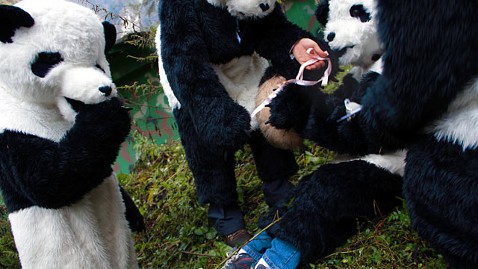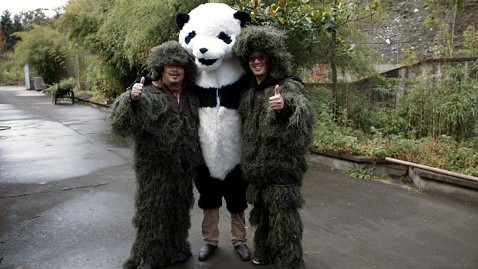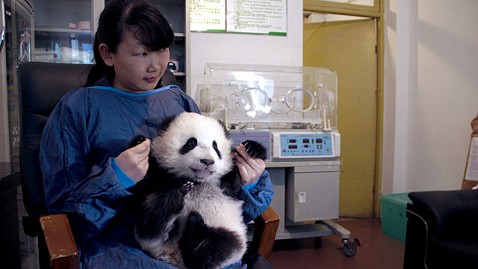Panda-monium: Chinese Researchers Don Panda Suits To Study Pandas

Researchers dressed in panda take measurements and health stats on a cub. Credit: Karson Yiu/ABC
ABC News’ David Wright and Karson Yiu report:
When ABC News first visited the Wolong Panda Research Center a few years ago, it was a thriving tourist attraction and China’s most successful panda breeding facility, home to more than 60 adorable panda cubs.
But now Wolong has the feel of “Jurassic Park: The Lost World.” Not yet recovered from the 2008 earthquake that ripped through China’s Sichuan Province, the tourist signs and buildings are still there, but the enclosures are mostly empty. The place is now overgrown with bamboo.
Doug Chou is one of a handful of Chinese researchers who stayed on to care for the six bears, mothers and cubs, that remain at Wolong.
“I would describe my job as caretaker or babysitter for Panda,” Chou said through a translator.
It’s a job he takes seriously, so much so that sometimes the babysitter even dresses up like one of his charges. Whenever Chou and the other researchers go out to check up on the panda cubs they wear giant panda costumes. A silly suit worn for a serious purpose: they don’t want the cubs growing too attached to humans because someday they hope to release the pandas into a nearby unsupervised reserve.
These fluffy black-and-white disguises make for what is, quite possibly, the oddest-looking doctor’s house call on Earth.
In China, when it comes to pandas, they tend to take conversation measures to the extreme. For instance, in nearby Chengdu, where they relocated the breeding program after the 2008 quake, researchers get mating couples in the mood by showing them “panda porn,” videos of other copulating panda couples to help the bears understand what to do.
The researchers came up themselves with the unusual way of dressing up to study the bears up close. The costumes are tailor made for the center.
The “Nightline” team – in full panda disguise – accompanied the researchers into the panda enclosures as they quietly weighed a 4-month-old cub, the pretend pandas using a clipboard to take notes on their health and progress.

ABC's David Wright dons a panda suit, while producer Karson Yiu and camera man Gamay Palacios dressed as shrubberies, to enter a panda enclosure at the Wolong Panda Research Center in China. Credit: Karson Yiu/ABC News
Usually only the pandas are there to witness the odd monthly ritual.
“I like this job. It’s like taking care of my own child,” one female researcher said through a translator.
It’s very difficult to see out of the huge costume panda head, and that makes the scientists’ work a lot more difficult. But they go about their business in all earnestness.
Kevin O’Reilly, an American conservationist with the group Panda Mountain-USCEF, has been spending time in Sichuan surveying panda habitat. Of the Chinese researchers in panda suits, he takes the view: “Hey, whatever works.
“I think it’s an interesting way of going about [handling pandas],” O’Reilly said. ”I feel that they can still smell a person no matter what they look like but it’s a step in the right direction.”
Researchers believe these precautions might help the pandas survive on their own in a few years when they move to stage two of their captivity – the larger panda sanctuary where they must fend for themselves unsupervised, one step closer to life in the wild.
 A researcher at the Wolong Panda Research Center in China hold a cub. Credit: Karson Yiu/ABC News
A researcher at the Wolong Panda Research Center in China hold a cub. Credit: Karson Yiu/ABC News